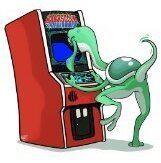
Troubleshooting Steps:
The first thing that I do whenever I deal with a non-functional coil is I check the coil itself. On a pinball machine, it is super easy to do this typically. The first thing you would do is remove the lock bar and playfield glass. Next, be sure to remove the balls themselves. This is an important step, as when you are lifting up the playfield, they can free themselves from the trough, potentially causing damage to the plastics or if you are REALLY unlucky, the back glass. After the balls are removed, lift up the playfield and secure it on the kickstand (or whatever means that particular unit has for doing such. For Black Knight, it has a kickstand so that makes it easy.
Upon visual inspection of the coil, I could see that it is super burnt, meaning that it was constantly engaged for way too long. You should be able to move the piston that solenoid pushes with your hand under normal circumstances and it should move smoothly. This one however was seized, indicating that the coil or sleeve needed to be replaced. This case was a bit extreme, so the coil is just going to be replaced. This happens for a few reasons: return side of the coil is shorted, the switch telling the mainboard to engage it was stuck, or something in the drive circuit was damaged. The drive transistor is typically the first place I check if there are no visible shorts, as those fail pretty often as they are hard working.
Looking at the manual, it was really easy to identify which part of the circuit to look at. You can typically find pinball manuals online on websites like ipdb.org. Each manual is different, but manuals by Williams typically were comprehensive. Table 2 and 4 told me the solenoid number (02), what coil to replace it with, and which drive transistors were involved.
With the transistor in question identified, I could easily take a look at the board. The only problem, is that Williams did NOT use silkscreen on the gameboards during this time, so you have to refer to the component layout diagram in the manual. You can also double check the schematics to make sure there wasn't a mistake, as well see the rest of the circuit to inspect.
So now looking at the board, I could see little balls of solder on the cooling mount tab and discoloration, a strong indicator that it got pretty hot. At this point, I was fairly confident that this was the issue. The 2N4401 that drives the drive transistor could also have failed, but that happens a lot less than the drive transistor itself as it is working with a lot less. The 7408 could also fail, but many times you would see multiple coils having issues. So I decided to just replace the drive transistor at Q17 with a TIP102.
After replacing the drive transistor, the coil performed as it should. In order to avoid excessive coil damage like this, make sure that your solenoid fuse is the correct value (the manual has that information and there is typically a fuse chart in the back box) and if you see or hear a solenoid fire and get stuck, it is a good idea to turn off the game and investigate. Coils are still made but are more expensive than a simple switch adjustment, just replacing the drive transistor or coil sleeve, and fuses are cheap so use the right value.
Solution: Replace bad solenoid and Q17 (TIP102)
- Read more...
- 7 comments
- 287 views

